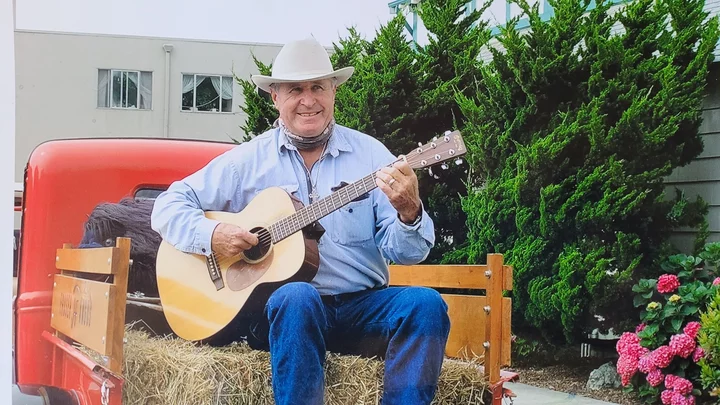OBITUARY: Edward Leroy Nevills, 1938-2023
LoCO Staff / Monday, June 12, 2023 @ 7:05 a.m. / Obits
Ed
was born February 16, 1938 in Eureka to Ralph and Gertrude (Smith)
Nevills. He passed on May 1, 2023 in Fortuna after a short battle
with cancer.
Ed married Frances “Fran” Brady June 12, 1959. They had two children, Sonja and David.
Ed worked for AT&T until his retirement then he and Fran became snowbirds spending many winters in Arizona.
In his later years, he found love again with Pat Overholt. Ed took Pat on her first camping trips and Pat taught Ed to love sports — schooling him on the rules, the players and her favorite coaches.
Ed was preceded in death by his parents, Fran and his daughter Sonja.
He is survived by his loving Pat, son Dave and wife Dayna, two granddaughters (Amanda and Katie), great-grands Amelia, Scarlett, Addy, Lexy, Zarina and Sophia, his sisters and their husbands Margaret and Perry Huff and Judy and Peter Cookson, and Pat’s family.
A celebration of life will be held June 25 from 1 to 3 p.m. at the Veterans Memorial Building in Fortuna. Lunch will be served.
###
The obituary above was submitted on behalf of Ed Nevills’ loved ones. The Lost Coast Outpost runs obituaries of Humboldt County residents at no charge. See guidelines here. Email news@lostcoastoutpost.com.
BOOKED
Today: 4 felonies, 13 misdemeanors, 0 infractions
JUDGED
Humboldt County Superior Court Calendar: Yesterday
CHP REPORTS
No current incidents
ELSEWHERE
RHBB: Brass, Banners, and a Bit of Chaos: Hundreds Rally at Eureka Courthouse Today
RHBB: [UPDATE 2:53 p.m.] Medical Emergency on Northbound Highway 101 Near Fields Landing
Times-Standard : Humboldt County health insurance rates jump $182 per month
Times-Standard : Civic calendar | Eureka brings back transgender sanctuary resolution
OBITUARY: William (Bill) Russ McBride, 1933-2023
LoCO Staff / Monday, June 12, 2023 @ 6:50 a.m. / Obits
William “Bill” Russ McBride of Bear River passed away Friday, May 26 at the age of 89. He was born July 7, 1933 on the family ranch to Rex and Viola McBride. He was preceded in death by his parents and brother Andy.
Bill was an avid adventurer, rancher, hunter, pilot, entertainer and watercolor artist. He was a committed volunteer in his community, playing guitar and singing at the Ivanhoe in Ferndale and at local assisted living facilities. He was a member of the Ferndale Community Church. Bill was a crop duster for 15 years and a lifelong rancher, and was dedicated to the preservation of the family ranches where he was born and lived for most of his 89 years.
Bill was a Marine and served during the Korean War and was always eager to recognize the service of others. Bill traveled extensively, taking 22 trips to Africa and other places, hunting and taking watercolor classes. Bill was also a teacher of watercolor.
Bill is survived by his wife, Gadie, brother Jon McBride, sons William McBride II (Angela) of Arizona, Robert McBride of New Zealand, and daughters Cathy LeFleur of Washington and Peggy Norton (Ron) of California. He is also survived by his stepson Hugo Klopper (Liz) of California and stepdaughter Rentia (Paul) of Oklahoma. Bill had 15 grandchildren and two great-grandchildren.
Bill was a beloved member of the family and will be missed by all. Bill had a way of making everyone around him feel special.
A memorial service will be held July 22 at noon at the Ferndale Community Center, 100 South Berding Street in Ferndale.
###
The obituary above was submitted on behalf of Bill McBride’s loved ones. The Lost Coast Outpost runs obituaries of Humboldt County residents at no charge. See guidelines here. Email news@lostcoastoutpost.com.
GROWING OLD UNGRACEFULLY: Creation Science
Barry Evans / Sunday, June 11, 2023 @ 7 a.m. / Growing Old Ungracefully
“Science is about finding useful descriptions of the world; by useful I mean they allow us to make predictions … or explain already existing observations. The simpler an explanation, the more useful it is.”
— Sabine Hossenfelder, Existential Physics
###
In 1650, James Ussher, archbishop and professor at Trinity College in Dublin, published his calculation proving that the first moment of Creation, per the Book of Genesis, occurred at 6 p.m. on October 22, 4004 BC. (According to Neil Gaiman and Terry Pratchett’s novel Good Omens, his estimate was inaccurate “by almost a quarter of an hour.”) Rather than scoff, the late evolutionist Stephen Jay Gould wrote, “Ussher represented the best of scholarship in his time. He was part of a substantial research tradition, a large community of intellectuals working toward a common goal under an accepted methodology.”
It’s pretty hard to actually prove Ussher wrong. God could have faked the evidence, putting everything in place for us to find later on. Meanwhile, the geological record puts Earth at about 4.6 billion years old, a tad longer than Ussher’s six thousand years, but that’s science for you. Why should we believe science over the Bible? Because, per physicist and science communicator Sabine Hossenfelder, above, it’s useful. And it’s useful because it simplifies.
Take creation, Genesis vs. the so-called Big Bang theory. Genesis is complicated! For Ussher to make his calculation think of all the data required to put everything perfectly in place 6,000 years ago (complete with all that fake news). Then try to deduce anything from the Genesis story—how the 100-odd chemical elements were created, for instance. The real problem is that you can’t really do anything with the Genesis account. It’s not useful.
“The garden of Eden with the fall of man,” Jan Brueghel the Elder and Peter Paul Rubens. Public domain, via Wikimedia.
Compare that with the modern scientific story how those elements were formed, starting with the so-called Big Bang. Between the concordance model* and quantum theory (both of which require just a few input values), science can explain how elements formed. From simple initial conditions we can explain a lot. (This is reductionism.) Unlike Genesis, the scientific story is useful. You couldn’t end up with a smartphone if you got your science from the Bible.
* The currently accepted cosmological model, also known as “Lambda CDM,” which puts the Universe at 13.7 years old, says that it’s expanding at about 70 km/second per megaparsec, and that it consists mostly of so-called dark matter and dark energy. It doesn’t include the hypothetical Big Bang itself (neither big nor a bang), which is outside the purview of physics. Possibly forever.
Big Bang cosmology (NASA)
Of course, today’s science won’t be the last word. Science is an ongoing process of refining knowledge, striving towards truth without ever reaching it. For instance, it’s only about 160 years since one of the best scientists of his day, physicist Lord Kelvin (William Thompson) estimated the age of the Earth to be between 20 and 400 million years. He didn’t know about radioactivity, the “missing” source of energy that explains why our planet hasn’t frozen. Similarly with the sun: not knowing about nuclear fusion in 1860, Kelvin had no way of understanding how the sun could be more than 20 million years old.
Generations from now, scientists may revise or toss out the concordance model, or quantum theory, or the standard model of particle physics + general relativity, currently our best bets for big-picture understanding of the Universe and everything in it. But, unlike Ussher, or even Kelvin, what we’ve got now is useful. Quantum theory explains why your smartphone works (and allows chip makers to make next year’s model faster and smaller, albeit pricier); while general relativity empowers that phone to tell you where you are within about a yard. (When I tell my drone to Return to Home, it lands within two feet from where it took off, thanks to half a dozen or so satellites 22 thousand miles overhead.)
So science = simple explanations = useful. What’s not to love?
PS: New book just out! In color!
HUMBOLDT TEA TIME: Local Independent Media Man Eric Black on His Peregrinations Through His Work and the World
LoCO Staff / Saturday, June 10, 2023 @ 3 p.m. / People of Humboldt
Today in tea: Arcata’s Eric Black, who you may know from his reporting stints on KHSU, KMUD and/or KINS, or who you may know through his YouTube channel, Arcata News.
Discussed: What brought Eric to Humboldt from the Bay Area, and how a three-year spell in Israel made him realize that he will always be an American. His “passionate” (the Outpost’s John Kennedy O’Connor’s term) reporting on the Arcata Gateway Plan and offshore wind energy. Plus: Managing the late, lamented Has Beans; juggling; speaking Arabic; and more!
In honor of our guests unshakable Americanness, today’s tea time snack is 3-Ingredient Crescent Hot Dog Rollups. Press play on the video above, and feel free dunk your rollups in your peppermint/ginger herbal tea as we go along. You’re watching us, we’re not watching you!
THE ECONEWS REPORT: Confused by the Cones on Broadway?
The EcoNews Report / Saturday, June 10, 2023 @ 10 a.m. / Environment
Photo: Caltrans.
Let’s face it: Broadway sucks. Especially for pedestrians and non-car users. Thankfully, Caltrans recognizes the deep suckiness of Broadway and is committed to making it better.
You may have seen cones and temporary bollards and wondered, “WTF?!” Some of those are part of a “pop-up” demonstration of potential measures to make the road just a little bit safer — from bulbouts and curb extensions to improve visibility of pedestrians and to slow vehicle speeds when turning to “refuse islands” in the left-hand turn lanes — others (those north of Wabash) are part of a construction project.
When walking, biking, driving or moving yourself by some other unspecific means through Broadway, take note of how your behavior is modified by these demonstration pop-ups or whether you feel safer as a result. Caltrans wants to know! Go to this SurveyMonkey to share your feedback
Jeff Pimentel joins the show to discuss how Caltrans is considering safety improvements to Humboldt’s most dangerous road.
###
RELATED READING:
- What the Heck’s Going on With Broadway in Eureka? Caltrans’ ‘Pop-Up Demonstration,’ Explained, May 24.
HUMBOLDT HISTORY: The Mystery of Frank Winters, Eureka’s Pickle Man
Louis Long / Saturday, June 10, 2023 @ 7:15 a.m. / History
Oldtimers who lived in the South Park area (Wabash and Broadway) from 1906 to 1912 will remember Frank Winters, known around town as “The Pickle Man.”
His place of business was across Broadway from the old South Park Hotel. There were several stables there and he rented two of them. One was for his living quarters and the other for his kitchen, for his assorted creations from pickles such as relishes, chow-chow, sweet pickles, sour pickles, catsup and hominy.
He had a brother in Oregon who shipped him the pickles by the barrel and he made the above-mentioned products, in the place I just mentioned, from them. Most people agree that his products were much better than the 57 varieties at that time.
He would never allow anyone around when he was cooking up his secret formulas. I know because I was one of his neighborhood door-to-door salesmen when I was eight or nine years old.
Mr. Winters paid real well — 20 cents on the dollar, which was good for those days, but his merchandise was also high for those days so I didn’t sell too much, but to make 40 to 60 cents for a few hours’ work, I thought, was real good.
He had a lot of customers up town and during school vacation he hired me to go along and hold his horse while he was selling his wares in various hotels and saloons.
His horse, Tommy, was an ex-fire horse, having pulled the Eureka steam pumper at one time. One day, I was with Mr. Winters and he was in a sloon selling pickles when the fire whistle blew.
Tommy struck out for the fire house. He was too much for me to hold, but I did guide him lickety-split to the fire barn, without mishap!
Besides being an excellent pickle man, Mr. Winters was also quite a showman. On Sunday afternoons he often put on a free show with his horse Tommy doing many tricks. Mr. Winters had a trick of making a $20 gold piece disappear. He would palm it somehow and tell me that if I could find it, it was mine. I never did find it! I was told that at one time he was in vaudeville and came from a show family.
Around 1912 Mr. Winters disappeared from Eureka. Nobody ever knew what became of him. He walked away leaving everything behind, including his horse. The newspaper thought it might have been foul play. If any old-timer has the answer, I would like to hear from him.
###
The story above was originally printed in the January-February 1977 issue of The Humboldt Historian, a journal of the Humboldt County Historical Society, and is reprinted here with permission. The Humboldt County Historical Society is a nonprofit organization devoted to archiving, preserving and sharing Humboldt County’s rich history. You can become a member and receive a year’s worth of new issues of The Humboldt Historian at this link.
After Closing Its Doors Late Last Year, Singing Trees Recovery Center Will Reopen Next Week Under New Ownership
Stephanie McGeary / Friday, June 9, 2023 @ 4:20 p.m. / News
Singing Trees on Highway 101, south of Garberville will reopen Monday! | Images provided by counselor Marilynne Susie Walpole
Many members of the community were saddened to hear the news last November that Singing Trees Recovery Center – which had served as a drug detox and rehabilitation center in Southern Humboldt for more than 30 years – was permanently closing its doors.
Now, after six months of uncertainty about what would happen to the facility, KMUD News recently reported that Singing Trees is set to reopen on Monday, June 12 under the ownership of non-profit Pure Solution Family Services, and will again offer recovery treatment for those in need.
“We’ve gotten so much support from the community and it’s been really amazing,” Courtney Bell, the new manager of Singing Trees, told the Outpost in a phone interview Friday. “The old owners put their lives into it and they’re really happy that it’s reopening.”
Bell said that Pure Solutions took over the property in January, but a few setbacks – including the storms, which caused some damage on the property – have delayed the opening from what was originally scheduled. Currently the company is “leasing to own” the property, Bell said. So, Patti Watson’s family still technically owns the property for now, but Pure Solutions is paying it off and is in charge of all of the maintenance and upkeep.
When interviewed by the Outpost in November, Watson said the two main reasons for the closure were staffing issues and the expensive maintenance of the center’s aging infrastructure. And Bell said that though the owners put in a lot of work to keep the facility operational, there was a lot that had to be done before reopening. Since taking over Singing Trees, the new operators have already replaced the electrical and some of the flooring and completely remodeled the kitchen and the counseling room.
Above and below: Some of the remodeled interior
Some sections of the center – like the famous sweat lodge – were in such bad repair that they had to be temporarily closed. So, Bell said, the sweat lodge will not be open for a while, but the staff is working to get it back up and running eventually. Bell added that the community AA and NA meetings that were held on the weekends will also return to the center eventually, but they will not be held immediately.
As far as the staffing issue, Bell said that this has not been a problem for the new center. Several Pure Solutions staff members, including Bell, have moved over to the recovery center and some of the Singing Trees staff, including chefs and counselors, have been rehired.
In addition to having some of the same staff, Singing Trees will offer many of the same services as before. The center will still hold 20 beds and offer options for two-week, 30-day, 60-day and 90-day rehabilitation programs. In addition to providing group and one-on-one counseling, the center will also implement some of the holistic healing approaches previously offered, such as yoga classes and spending time in nature.
Pure Solution Family Services was started by founder Amber Bedell as a nonprofit that offers wraparound services for adopted children and their families in Humboldt, Mendocino and Butte Counties. Though Pure Solution does not usually focus on recovery from substance abuse, it does focus on mental and behavioral health services, which includes addressing problems with addiction and implements holistic approaches to addressing these issues.
In an interview with KMUD, Bedell said that the taking over Singing Trees was an “amazing universe lineup” and that, after learning that the center had closed, she connected with the owners, who were very supportive of selling the space to someone who planned to reopen it as a recovery center.
Though there will be many of the same services offered at Singing Trees, Bedell also said that the center will not be as focused on 12-Step recovery programs like NA and AA and will offer “a variety of modalities.” The center will still offer 12-Step materials and utilize some of those approaches, Bedell said, but will take bits from other recovery models and tailor a treatment plan to the individual.
“It’s just not a one-size-fits-all, cookie-cutter approach — we believe in co-creation and we believe in empowering people,” Bedell told KMUD. Often people know the best what they need, they just don’t often have access or the ability to talk about it without a guide. So we can be that guide.”
Singing Trees Recovery Center will officially reopen on Monday, June 12. If you are struggling with addiction you can call the center at 707-247-3495.









